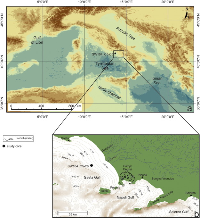Marine response to climate changes during the last five millennia in the central Mediterranean Sea
Margaritelli G., M. Vallefuoco, F. Di Rita, L. Capotondi, L.G. Bellucci, D.D. Insinga, P. Petrosino, S. Bonomo, I. Cacho, A. Cascella, L. Ferraro, F. Florindo, C. Lubritto, P.C. Lurcock, D. Magri, N. Pelosi, R. Rettori, F. Lirer.
Global and Planetary Change, 142, 53-72, doi:10.1016/j.gloplacha.2016.04.007.
Abstract
We present a high-resolution paleoclimatic and paleoenvironmental reconstruction of the last five millennia from a shallow water marine sedimentary record from the central Tyrrhenian Sea (Gulf of Gaeta) using planktonic foraminifera, pollen, oxygen stable isotope, tephrostratigrapy and magnetostratigrapy. This multiproxy approach allows to evidence and characterize nine time intervals associated with archaeological/cultural periods: Eneolithic (base of the core–ca. 2410 BCE), Early Bronze Age (ca. 2410 BCE–ca. 1900 BCE), Middle Bronze Age–Iron Age (ca. 1900 BCE–ca. 500 BCE), Roman Period (ca. 500 BCE–ca. 550 CE), Dark Age (ca. 550 CE–ca. 860 CE), Medieval Climate Anomaly (ca. 860 CE–ca. 1250 CE), Little Ice Age (ca. 1250 CE–ca. 1850 CE), Industrial Period (ca. 1850 CE–ca. 1950 CE), Modern Warm Period (ca. 1950 CE–present day). The reconstructed climatic evolution in the investigated sedimentary succession is coherent with the short-term climate variability documented at the Mediterranean scale.
By integrating the planktonic foraminiferal turnover from carnivorous to herbivorous–opportunistic species, the oxygen isotope record and the pollen distribution, we document important modification from the onset of the Roman Period to the present-day. From ca. 500 CE upwards the documentation of the cooling trend punctuated by climate variability at secular scale evidenced by the short-term δ<sup>18</sup>Ois very detailed. We hypothesise that the present day warm conditions started from the end of cold Maunder event. Additionally, we provide that the North Atlantic Oscillation (NAO) directly affected the central Mediterranean region during the investigated time interval.
http://www.sciencedirect.com/science/article/pii/S0921818115301673


